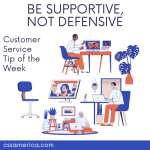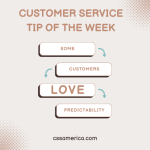
It’s a great golf analogy. The harder you swing, the more your swing faults are magnified. If you usually hit the ball slightly to the right, when you swing harder, you may start hitting WAY right. Then why swing harder, you ask?
The reason you swing harder is to test your swing at the practice range BEFORE you get on the course. You want to get a better sense of the issues, and then you can improve.
You can do the same thing in the world of customer service. You may be very effective at dealing with those 90%-95% of customers that walk through the door or that call you on the phone. You may be great in dealing with those complaints that you hear every day. It may be easy to engage that person who is smiling as they walk into your facility. You might find it a pleasant challenge to deal with that difficult e-mail the comes from a co-worker.
But if you want to understand the holes in your own personal approach to customer service, if you want to understand how to get better in how you engage co-workers and your clients, if you want to get better at those most challenging 5-10% of interactions, then swing harder. Here are three examples of how to swing harder in practice.
First, figure out how you could possibly resolve some customer complaints in half the time.
Second, ask a co-worker to come up with five scenarios dealing with product or service issues that are very unusual or complex. Then role-play those issues.
Third, use your company’s FAQ list, and identify three different scenarios that are not covered by the FAQs. Then identify specifically what you need to know about your people, your products, your processes, and your policies to address those scenarios.
If you want to get great at customer service, challenge yourself to address situations you rarely have to deal with so that – when they arrive – you’re more comfortable and more confident.
Swing a Little Harder.
Signup for FREE Tips! Contact Us More Resources for You Visit Our Home Page























